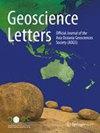根据印度尼西亚苏门答腊岛的最新全球导航卫星系统观测结果确定巽他板块的欧拉极参数
IF 4.3
3区 地球科学
Q1 GEOSCIENCES, MULTIDISCIPLINARY
引用次数: 0
摘要
为了在 2004 年 M9.2 亚齐地震后为印度尼西亚苏门答腊岛地震潜力评估提供精确的巽他兰板块欧拉极参数,我们采用了苏门答腊岛的 37 个新全球导航卫星系统(GNSS)观测数据以及印度支那和马来西亚根据 2014 年国际地面参考框架(ITRF2014)公布的 30 个转换速度。使用 Bernese v.5.2 软件处理了 37 个全球导航卫星系统数据。全球导航卫星系统速度是通过坐标时间序列分析和最小二乘法计算得出的。在估算欧拉极参数时使用了网格搜索算法,并通过自举重采样进行了验证。优化后的欧拉极参数为纬度 45.63 ± 0.45°,经度 - 88.71 ± 0.38°,逆时针方向角速度 0.337 ± 0.002°/Myr。此外,残余速度在空间上显示出明显的系统模式,这可能意味着地震后的小变形、西藏地壳流动或巽他板块由多个微板块组成的假说。本文章由计算机程序翻译,如有差异,请以英文原文为准。
Determination of Euler pole parameters for Sundaland plate based on updated GNSS observations in Sumatra, Indonesia
To provide a precise Euler pole parameter of Sundaland plate for earthquake potential evaluation in Sumatra, Indonesia after the 2004 M9.2 Aceh earthquake, we adopted 37 new Global Navigation Satellite System (GNSS) observations in Sumatra and 30 transformed published velocities in Indochina and Malaysia under the International Terrestrial Reference Frame 2014 (ITRF2014). The 37 GNSS data were processed using the software Bernese v.5.2. The GNSS velocities were calculated by the coordinate time series analysis with the least squares method. The grid search algorithm was used in Euler pole parameter estimation, which was validated using the bootstrap resampling. The optimized Euler pole parameters are the latitude of 45.63 ± 0.45°, the longitude of − 88.71 ± 0.38° and the angular velocity of 0.337 ± 0.002°/Myr in counterclockwise direction. Besides, the distinguishable and systematic pattern in space is shown in the residual velocities, which may imply the possibility of minor postseismic deformation, Tibetan crustal flows, or the hypothesis that the Sundaland Plate is composed of several microplates.
求助全文
通过发布文献求助,成功后即可免费获取论文全文。
去求助
来源期刊

Geoscience Letters
Earth and Planetary Sciences-General Earth and Planetary Sciences
CiteScore
4.90
自引率
2.50%
发文量
42
审稿时长
25 weeks
期刊介绍:
Geoscience Letters is the official journal of the Asia Oceania Geosciences Society, and a fully open access journal published under the SpringerOpen brand. The journal publishes original, innovative and timely research letter articles and concise reviews on studies of the Earth and its environment, the planetary and space sciences. Contributions reflect the eight scientific sections of the AOGS: Atmospheric Sciences, Biogeosciences, Hydrological Sciences, Interdisciplinary Geosciences, Ocean Sciences, Planetary Sciences, Solar and Terrestrial Sciences, and Solid Earth Sciences. Geoscience Letters focuses on cutting-edge fundamental and applied research in the broad field of the geosciences, including the applications of geoscience research to societal problems. This journal is Open Access, providing rapid electronic publication of high-quality, peer-reviewed scientific contributions.
 求助内容:
求助内容: 应助结果提醒方式:
应助结果提醒方式:


